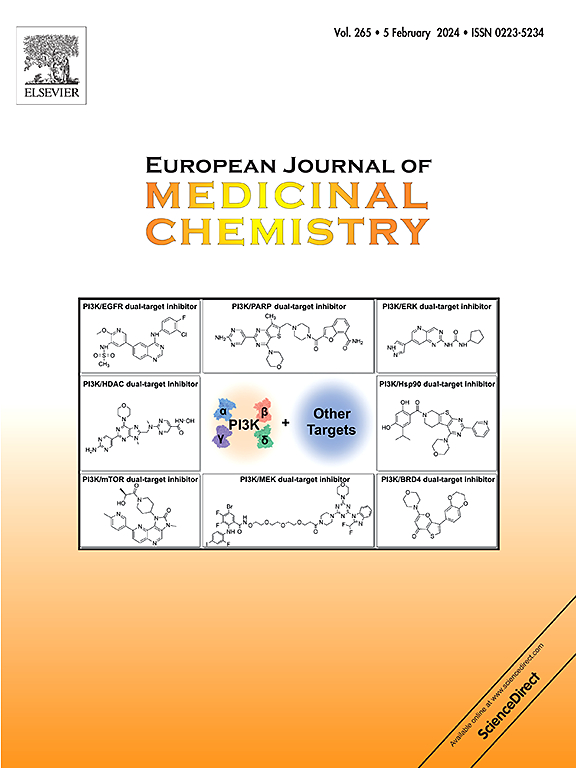基于咖啡酸的新型多功能分子治疗阿尔茨海默病的设计、合成和生物学评价
IF 6
2区 医学
Q1 CHEMISTRY, MEDICINAL
引用次数: 0
摘要
阿尔茨海默病(AD)是一种多方面的神经退行性疾病,其特征是乙酰胆碱水平低、氧化应激、β淀粉样蛋白(a β)聚集和金属失调。本研究旨在通过设计和合成体内有效的咖啡酸衍生物作为多功能胆碱酯酶抑制剂,解决与阿尔茨海默病(AD)管理相关的天然产物的局限性。为了进一步提高咖啡酸对胆碱酯酶的抑制作用及其多功能特性,对其进行了综合构效关系(SAR)分析。在合成的化合物中,12d作为铅分子,对BChE (IC50=9.65±0.08 μM)具有选择性的AChE抑制作用(IC50=3.72±0.34 μM),比母体咖啡酸(AChE和BChE分别为35.39±0.66%和18.94±0.91%)有显著的改善。酶动力学研究表明12d对人乙酰胆碱酯酶(hAChE)和马BChE (eqBChE)具有混合抑制机制。分子对接和分子动力学模拟表明,12d与AChE (TRP86、HIS447、SER293和ARG296)和BChE (TRP82、LEU286、HIS438、PHE329、G197和TRP231)的关键活性位点残基相互作用。此外,12d在DPPH实验中显示出较强的抗氧化活性,显示出较强的自由基清除作用,IC50值为6.32±0.15 μM。12d还显示出金属螯合特性,表明其有可能预防金属诱导的神经毒性。此外,血脑屏障(BBB)通透性预测(Pe = 4.12±0.40)表明12d可以穿过血脑屏障。通过硫黄素T (ThT)荧光和透射电镜(TEM)分析证实了12d调节a - β1-42自聚集的能力。进一步评价12d对SH-SY5Y神经元细胞抗氧化应激的神经保护作用。预处理后以不同浓度共处理12d,可有效保护细胞免受h2o2诱导的神经毒性。此外,正如MitoSOX和H2DCFDA检测所显示的那样,12d显著降低了细胞内活性氧(ROS)。最后,在体内东莨菪碱诱导的AD小鼠模型中,12d在y迷宫测试中改善了空间记忆。此外,它能有效地恢复AChE和BChE水平,并显示出强大的体外抗氧化活性。这些发现共同强调了12d作为一种有前途的多靶点定向配体(MTDL),具有治疗AD的潜力。本文章由计算机程序翻译,如有差异,请以英文原文为准。

Design, synthesis, and biological evaluation of caffeic acid-based novel multifunctional molecules for the management of Alzheimer's disease
Alzheimer’s disease (AD) is a multifaceted neurodegenerative disorder characterized by low levels of acetylcholine, oxidative stress, amyloid-beta (Aβ) aggregation, and metal dysregulation. This study aimed to address the limitations associated with natural products for Alzheimer's disease (AD) management by designing and synthesizing in vivo efficacious caffeic acid derivatives as multifunctional cholinesterase inhibitors. A comprehensive structure-activity relationship (SAR) analysis was carried out in a calibrated manner to improve upon the cholinesterase inhibitory potential of caffeic acid along with its multifunctional properties. Among the synthesized compounds, 12d emerged as a lead molecule, exhibiting selective AChE inhibition (IC50=3.72±0.34 μM) over BChE (IC50=9.65±0.08 μM), with significant improvement over parent caffeic acid (AChE and BChE 35.39 ± 0.66 % and 18.94 ± 0.91 %, respectively). Enzyme kinetic studies revealed 12d as a mixed inhibition mechanism against human AChE (hAChE) and equine BChE (eqBChE). Molecular docking and molecular dynamics simulations demonstrated that 12d interacts with key active-site residues of AChE (TRP86, HIS447, SER293, and ARG296), and BChE (TRP82, LEU286, HIS438, PHE329, G197, and TRP231). Additionally, 12d displayed potent antioxidant activity in the DPPH assay, exhibiting a strong free radical scavenging effect with an IC50 value of 6.32 ± 0.15 μM. 12d also demonstrated metal-chelating properties, suggesting its potential to prevent metal-induced neurotoxicity. Furthermore, blood-brain barrier (BBB) permeability predictions (Pe = 4.12 ± 0.40) indicated that 12d can cross the BBB. 12d’s ability to modulate Aβ1-42 self-aggregation was confirmed through Thioflavin T (ThT) fluorescence and transmission electron microscopy (TEM) analyses. The neuroprotective potential of 12d against oxidative stress was further evaluated in SH-SY5Y neuronal cells. Pretreatment followed by the co-treatment with 12d at varying concentrations effectively protected the cells from H2O2-induced neurotoxicity. Also, 12d significantly reduced intracellular reactive oxygen species (ROS), as MitoSOX and H2DCFDA assays demonstrated. Finally, in an in vivo scopolamine-induced AD mouse model, 12d improved spatial memory in the Y-maze test. Moreover, it effectively restored AChE and BChE levels while displaying potent ex vivo antioxidant activity. These findings collectively highlight 12d as a promising multitarget-directed ligand (MTDL) with therapeutic potential for AD management.
求助全文
通过发布文献求助,成功后即可免费获取论文全文。
去求助
来源期刊
CiteScore
11.70
自引率
9.00%
发文量
863
审稿时长
29 days
期刊介绍:
The European Journal of Medicinal Chemistry is a global journal that publishes studies on all aspects of medicinal chemistry. It provides a medium for publication of original papers and also welcomes critical review papers.
A typical paper would report on the organic synthesis, characterization and pharmacological evaluation of compounds. Other topics of interest are drug design, QSAR, molecular modeling, drug-receptor interactions, molecular aspects of drug metabolism, prodrug synthesis and drug targeting. The journal expects manuscripts to present the rational for a study, provide insight into the design of compounds or understanding of mechanism, or clarify the targets.

 求助内容:
求助内容: 应助结果提醒方式:
应助结果提醒方式:


